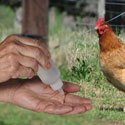
After handling poultry or visiting the coop, you should thoroughly wash your hands with soap and water, as recommended in “Protect Yourself and Your Family From Germs,” a poster distributed by the Centers for Disease Control. If soap and water are not readily available, the CDC recommends using a hand sanitizer until you are able to properly wash your hands. Unfortunately, many commercial hand sanitizers tend to have a disgusting and lingering odor, and using them often can wind up being expensive.
In his book Bird Flu, author Michael Gregor, MD, includes a recipe for alcohol-based hand sanitizer that costs about one-quarter the price of the same amount of commercially-available sanitizers, has little odor other than that of alcohol, and the mild odor dissipates rapidly. All you need to make your own effective, low-cost hand sanitizer is common rubbing alcohol and glycerin. Rubbing alcohol is inexpensive and readily available in grocery stores and drug stores in 16-ounce (2 cup) and 32-ounce (4 cup) bottles.
Vegetable glycerin, which acts as a moisturizer to keep the alcohol from drying your skin, is nontoxic, inexpensive, non-allergenic, and widely available in drugstores, natural food stores, and online in 4-ounce (½ cup) and 8-ounce (1 cup) bottles. One 4-ounce bottle is enough to mix half a dozen 32-ounce bottles of alcohol, which makes enough sanitizer to last the average family practically forever.
According to Dr. Gregor, his liquid sanitizer is more effective for routine hand decontamination than either soap or commercial gel sanitizers. He claims further that influenza and other enveloped viruses (the class of viruses that have a protective outer coat) are especially susceptible to alcohol sanitizers. Here’s his formula:
Homemade Hand Sanitizer
4 cups 70% rubbing alcohol
4 teaspoons of glycerin
Mix to make approximately one quart.
Being a liquid, this sanitizer may be dispensed from either a small squirt bottle or a hand pump. Apply a little to your hands and rub them together until the alcohol completely evaporates.
Since a little of this sanitizer goes a long way, the formula may be easily adjusted to make a smaller amount. To mix a 16-ounce bottle of alcohol, for example, add 2 teaspoons glycerin. To mix enough to fill an 8-ounce pump dispenser, combine 1 cup alcohol with 1 teaspoon glycerin.
This homemade hand sanitizer is helpful in other places besides the chicken coop. For example, our family keeps a squirt bottle in our pickup for use whenever we go to town, especially during winter flu season. So do yourself a favor and stock up on homemade hand sanitizer, and remember to use it after enjoying a visit with your feathered friends.
And that’s today’s news from the Cackle Coop.
Gail Damerow, author, Storey’s Guide to Raising Chickens

